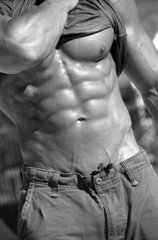Q: Dear Tom: would you please try to explain in laymen's terms exactly what happens when you start to burn body fat. I heard a statement that the fat cell has to get moved into the muscle cell for it to be released or burned. Thought you could explain a little better.
Sincerely,
Glenn P.
A: Earlier this week someone in our discussion forum wrote, "I haven't LOST any weight... I know EXACTLY where it went! I got a chuckle out of that because I "got" the joke, but truth is, most people really DON'T know where the fat goes or how the fat burning process takes place, so this is a really good question.
When stored body fat is burned for energy, the fat cell (also called an adipocyte) does not go anywhere or "move into the muscle cell", as it was suggested to you (although that's not too far off). The the fat cell (unfortunately) stays right where it is - on top of your muscles and under the skin in your thighs, stomach, hips, arms, etc. What happens is the fat cell simply releases its contents into the bloodstream as free fatty acids (FFA's).
So the fat is not burned right there in the fat cell, it must be liberated from the fat cell through some somewhat complex hormonal/biochemical pathways, and then transported to the tissues where energy is needed and that is where the FFA's are oxidized
When the FFA's are released from the fat cell, the fat cell shrinks and that's why you look leaner when you lose body fat - because the fat cell is now smaller. A small or "empty" fat cell is what you want.
Each of us inherits a pre-determined number of fat cells. This number may increase, especially through the growing childhood and teenage years, but it cannot decrease, except though such drastic (and dangerous) measures as liposuction.
What does change frequently is the SIZE of the fat cell. Body fat is basically just a reserve source of energy. The fat cell is the storage depot for this energy in the form of triglycerides (fat). The cell grows or shrinks in size depending on how "filled" it is.
Picture a balloon that is not inflated: It's tiny when not filled with air - maybe the size of your thumb. When you blow it up with air, it can expand 10 or 20 times it's normal size, because it simply fills up. That's what happens to fat cells: They start nearly empty (when you are lean), and when energy intake exceeds your needs, your fat cells "blow up" like balloons. (not a pretty picture, is it?)
When your energy needs exceed your intake, your body releases hormones and enzymes that signal your fat cells to release fat instead of keeping it in storage. Then the stored fat (energy) gets released into your bloodstream as FFA's and they are shuttled off to the muscles where the energy is needed. As blood flow increases to the active muscles, more FFA's are delivered to the muscles that need them.
An important enzyme called lipopoprotein lipase (LPL), then helps the FFA's get inside the mitochondria of the muscle cell, where the FFA's can be burned for energy. If you've ever taken a biology class, then you're probably heard of the mitochondria. This is the "cellular powerhouse" where energy production takes place and this is where the FFA's go to be burned for energy.
The fat cell however, is still right where is was before (in your thighs, lower abs, etc), waiting to be filled up with more fat if you're not careful (so keep using energy and burning more calories than you consume so your fat cells get empty and stay empty!)


















1 comment:
Nice article
do check this out
https://www.famfits.com/11-most-common-mistakes-in-bodybuilding/
Post a Comment